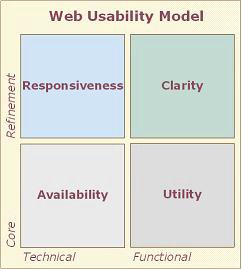The Dimensions of Usability
 Whenever specialists attach technical meanings to everyday words, they tend to create confusion and make their profession harder to penetrate. Some professions are masters of this. If you heard the words party, service, and cases in a sentence you might be looking forward to a celebration -- unless they were spoken by your lawyer.
Whenever specialists attach technical meanings to everyday words, they tend to create confusion and make their profession harder to penetrate. Some professions are masters of this. If you heard the words party, service, and cases in a sentence you might be looking forward to a celebration -- unless they were spoken by your lawyer.In the world of information systems, Usability is a case in point. Model is another -- especially since it can be a noun, a verb, or an adjective. All the same, today I am going to use a model to help me discuss the concept of usability!
In a previous post, I presented a framework for thinking about Web Site Usability. I divided usability into four dimensions, each of which is essential to the ultimate success of any site -- Availability, Responsiveness, Clarity, and Utility. The graphic illustrates the four dimensions of usability, and its layout reveals some further characteristics (Technical or Functional, Core or Refinement) of the four dimensions. This further classification scheme is not strictly essential to an appreciation of the underlying four-dimension model, but may be helpful when thinking about differences among the four aspects.
Horizontally, the Functional dimensions pertain to the purpose of a site and how it is used, the Technical ones concern its construction and delivery. Vertically, the dimensions I have labeled as Core represent the essential implementation of a site's function or of its delivery, the ones labeled as Refinement represent the form (or quality) of that implementation. For the architecturally minded reader, this distinction follows the classic saying of architect Louis Henri Sullivan that Form ever follows function. For the engineering-minded, the practical implication is this -- why worry about responsiveness if your site is not available consistently, and why work on refining the user interface if the site does not deliver the function the user needs?
Having said that, in practice people do recognize the need to address all four dimensions of usability, and tend to think about them about independently, and to work on them in parallel. This turns out to be both good and bad. It's good because it allows specialists in each of the four areas to focus on what they do best. Typically this means that:
- Business experts provide the content or specify the behaviors that are the site's purpose (Utility).
- Design and Usability specialists make it easy for customers to navigate the site (Clarity).
- Site developers build the site in ways that determine download speed (Responsiveness).
- IT staff manage the systems that keep the site up and running (Availability).
In one sense, I am objecting to something that is simply a matter of semantics. The English language meaning of usable (with a small 'u') is more inclusive than the professional definition favored by Usability experts (with a capital 'U'). As my opening paragraph implied, it may be confusing, but I can't expect an entire profession to redefine itself just because I don't like their choice of terminology! But given this difference in scope, it is interesting to see that the International Organization for Standardization (ISO) actually does define usability in a way that seems (on the face of it) to be closer to the viewpoint of a business:
ISO 9241-11: Guidance on Usability (1998)Ultimately, what really matters to the business owner is their site's utility -- the degree to which customers can achieve specified goals with effectiveness, efficiency and satisfaction. And unless you address all four dimensions of usability, you will not accomplish that. Rather you will drive away all but your most loyal customers, and those who are forced to use your site for other business reasons. Those who have choices will not be satisfied. They will abandon your site and find other ways to get the job done.
Usability is the extent to which a product can be used by specified users to achieve specified goals with effectiveness, efficiency and satisfaction in a specified context of use.This standard (which is part of the ISO 9241 series) provides the definition of usability that is used in subsequent related ergonomic standards. ISO 9241-11 explains how to identify the information that it is necessary to take into account when specifying or evaluating usability in terms of measures of user performance and satisfaction. Guidance is given on how to describe the context of use of the product and the measures of usability in an explicit way. It includes an explanation of how the usability of a product can be specified and evaluated as part of a quality system, for example one that conforms to ISO 9001. It also explains how measures of user performance and satisfaction can be used to measure how any component of a work system affects the quality of the whole work system in use.
At least where Web sites are concerned, the Usability profession has defined its role more narrowly. Most articles and books on Web Usability focus on the (many) aspects of clarity, and make only passing references to the importance of the other three dimensions. In my opinion, if writers and teachers would adopt the rather broader scope of the ISO definition (and that of the English dictionary), it would help to promote a more holistic Web site development process, and lessen the chance of the other dimensions being downplayed.
Some authors have done better at this than others. Tomorrow I will review a few books by leading authors on Web Usability, in the light of the four-dimensional Usability Model.


0 Comments:
Post a Comment